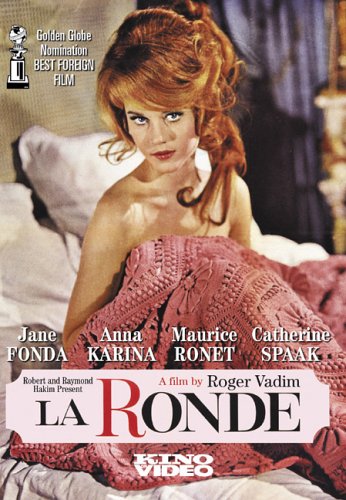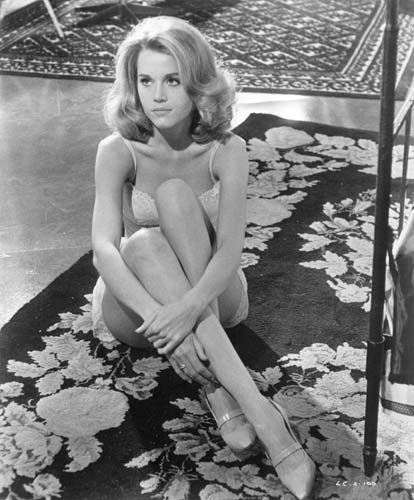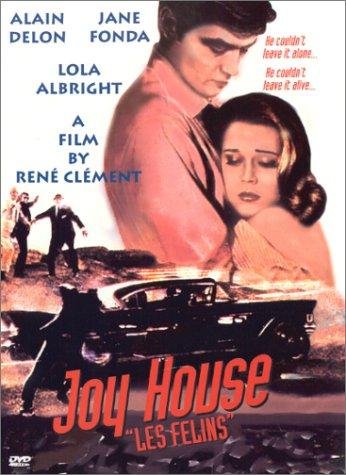 When a movie is released under various titles it usually means there are problems. It could be confusion over how to market it or a simple case of a movie that doesn’t fit clearly into any designated genre or maybe it’s a star-driven, major studio release that’s too quirky for the average moviegoer but yields enough curiosity value to inspire various promotional approaches to finding the right audience. All of these could apply to Joy House (1964), an international production based on a pulp fiction paperback by American author Day Keene and filmed on the Riviera near Nice. It stars English-speaking (Lola Albright, Jane Fonda, Sorrell Booke, George Gaynes of Tootsie fame) and French-speaking actors (Alain Delon, Andre Oumansky, Annette Poivre, Marc Mazza) and is also known as The Love Cage and Les Felins (the original French title). Joy House was not a popular success at the time (most critics were unkind in their coverage) but it is a favorite film of mine, flaws and all.
When a movie is released under various titles it usually means there are problems. It could be confusion over how to market it or a simple case of a movie that doesn’t fit clearly into any designated genre or maybe it’s a star-driven, major studio release that’s too quirky for the average moviegoer but yields enough curiosity value to inspire various promotional approaches to finding the right audience. All of these could apply to Joy House (1964), an international production based on a pulp fiction paperback by American author Day Keene and filmed on the Riviera near Nice. It stars English-speaking (Lola Albright, Jane Fonda, Sorrell Booke, George Gaynes of Tootsie fame) and French-speaking actors (Alain Delon, Andre Oumansky, Annette Poivre, Marc Mazza) and is also known as The Love Cage and Les Felins (the original French title). Joy House was not a popular success at the time (most critics were unkind in their coverage) but it is a favorite film of mine, flaws and all.
One of the biggest complaints from detractors of this offbeat ménage-a-trois thriller is the problem most international films encounter when they are filmed – or dubbed – in English (some actors are going to be hobbled by speaking in an unfamiliar tongue or the English dubbing is going to create an unnatural audio layer that removes you one step further from the original).
Compounding the language problem for some is a story about criminals, murder, subterfuge, sexual intrigue and double-crosses that could be played for tense suspense or as an exercise in film noir style. Instead French director Rene Clement prefers to concentrate on the sensual and the deceptive allure of beautiful surfaces in both the lush settings and the sexy protagonists. There is also a kinky sense of humor simmering just beneath the surface which seemed to offend the sensibilities of some reviewers who complained about the movie’s decadent and “sick” characters. 
Consider the storyline which has been transplanted from the sleazy urban milieu of Keene’s original novel to the sunny Mediterranean environs of a jet set resort area [Spoilers ahead]. Marc (Delon) is a two-bit hustler and playboy who makes the mistake of seducing the wife of an American gangster. Soon he is running for his life as hired hit men pursue him along the French Riviera. Taking refuge in a homeless shelter, he attracts the attention of Barbara (Albright), a wealthy widow, and her niece Melinda (Fonda), who distribute food to the poor on a weekly basis. The two women offer Marc room and board and a position as their chauffeur and he eagerly accepts, despite their strange behavior because the assassins have traced him to the mission. Once inside Barbara’s chateau, Marc begins to realize he is a pawn in some mysterious plot but what is his alternative? So he plays along, biding his time as both women demand more and more of his time.

Marc (Alain Delon in bathtub) is terrorized by thugs in Rene Clement’s Joy House aka Les Felins (1964).
The hothouse atmosphere and claustrophobic situation bears some similarities to such films as Robert Altman’s That Cold Day in the Park (1969) and the 1970 Nicholas Roeg-Donald Cammell cult item, Performance, but the fun factor is much higher here with Jane Fonda in an unabashed sex kitten role, Lola Albright as an enigmatic but highly desirable siren and Alain Delon, at the height of his European stardom, radiating animal cunning and nonchalant coolness.
Delon, in particular, was singled out at the time for his awkwardly delivered English dialogue by many but, as much as I would have preferred to hear him in French, he is always convincing as the slippery anti-hero. This was also his first major film in English and he would follow it with a major bid for American stardom in such films as The Yellow Rolls-Royce (1964), Once a Thief (1965) and Texas Across the River (1966) – none of which did the trick.

Joy House (1964 France) aka Les FÈlins aka The Love Cage, Directed by Rene Clement,
Shown: Jane Fonda
The real scene stealer here though is Jane Fonda, whose wild card performance veers between self consciousness and uninhibited provocation which is completely appropriate for her enigmatic character. Joy House marked the beginning of Fonda’s European phase when she tried to establish herself as an actress on her own terms. In her autobiography, My Life So Far, Fonda recalled, “..France seemed to be in the cards…French director Rene Clement flew to Los Angeles to pitch me a film idea that would co-star Alain Delon…I agreed. I liked the idea of putting an ocean’s distance between me, Hollywood, and my father’s long shadow. Moreover, France was then at the apex of the nouvelle vague, with young directors like Truffaut, Godard, Chabrol, and Malle, and Vadim. Clement was up in years and wasn’t part of this new wave, but he directed the brilliant Forbidden Games.”
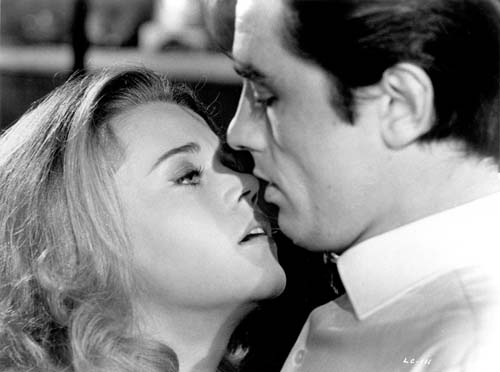
Joy House (1964 France) aka Les Felins aka The Love Cage, directed by Rene Clement, starring Jane Fonda & Alain Delon
According to biographer Christopher Andersen in Citizen Jane: The Turbulent Life of Jane Fonda, “Even before shooting began, Jane got things going. “I will undoubtedly fall in love with Alain Delon,” she declared. “I can only play love scenes well when I am in love with my partner.” No idle prediction. Within weeks of her arrival, Jane had broken up Delon’s long-standing affair with actress Romy Schneider….Likening her to France’s sexual icon of the 1950s, Brigitte Bardot, the press started calling her la BB Americaine.” It was no coincidence that Roger Vadim, the former husband of Bardot and director of the film that launched her breakthrough film …And God Created Woman in 1956, would soon come calling and reinvent Fonda’s screen image as a continental sexpot.
Fonda had previously met Vadim in Paris and later turned down an offer from him to star in a remake of La Ronde. But during the filming of Joy House, the two met again and began an affair which led to marriage and a collaboration on four film projects, beginning with Circle of Love (1964), Vadim’s take on La Ronde.

Barbara (Lola Albright, left) and Melinda (Jane Fonda) are charity volunteers who decide to hide Marc (Alain Delon), a fugitive on the run, in their home in Rene Clement’s Joy House (1964).
As for Joy House, Fonda would later remark, “There was no script and very little organization…It sort of threw me because I’m used to working within a structured framework. There was just too much playing it by ear for my taste. But Clement is still a wonderful director.”

Melinda (Jane Fonda) hides a mysterious man in her home in Joy House (1964 France) aka Les FÈlins aka The Love Cage, directed by Rene Clement
Although Fonda would dismiss most of the films she made during her European sojourn (and no one would make claims for any of them as great cinema), she looks sensational in Joy House and her performance is more entertaining to watch than some of her later, more acclaimed work after she became a serious Oscar winning actress; I cite the glum, morose mystery thriller The Morning After (1986) as an example. I think Pauline Kael succinctly captured her appeal during this period when she noted in her review of Barbarella that “Jane Fonda has the skittish naughtiness of a teen-age voluptuary. She’s the fresh, bouncy American girl triumphing by her innocence over a lewd, sadistic world of the future.” And that’s pretty much true of her performance in Joy House too.

Joy House (1964 France) aka Les Felins aka The Love Cage
Directed by Ren3 Clement starring Alain Delon and Lola Albright
Although Fonda and Delon emerge as the dominant protagonists in Joy House, Lola Albright makes a strong impression as the mysterious widow who sets the bizarre charade in motion. Sadly overlooked and underrated as an actress, Albright has been given few opportunities to shine in major roles throughout her career but the exceptions have been vivid and unforgettable – juicy supporting roles opposite Kirk Douglas in Champion (1949) and Frank Sinatra in The Tender Trap (1955), a moving, breakout performance as an aging stripper in the acclaimed indie drama A Cold Wind in August (1961) and a funny and oddly poignant appearance as Tuesday Weld’s cocktail waitress mom in Lord Love a Duck (1966). Albright deserved a better career but Joy House is a rare chance to see her get the showcase treatment in a chic European feature; she is at the height of her beauty and has rarely looked more gorgeous or sexy.

A cat races down the hallway in a baroque mansion in the erotic thriller Joy House (1964), directed by Rene Clement.
There are other things to savor here: The baroque art direction showcases Barbara’s chateau (the exteriors are the Villa Torre Clementina in Roquebrune-Cap-Martin, France) as a labyrinth of secret passageways, peepholes, sliding panels, mirrored walls and arty bric-a-brac like a shrunken head, Japanese pottery, erotic sculptures and abstract paintings. An unmistakably swinging sixties vibe is conjured up by Lalo Schifrin’s perky, playful score (some reviewers have complained that it is completely inappropriate for the movie’s dark tone) and Henri Decae’s black and white cinematography is appropriately seductive, even in the inferior DVD releases of Joy House from Image Entertainment and Koch Lorber (more on this below).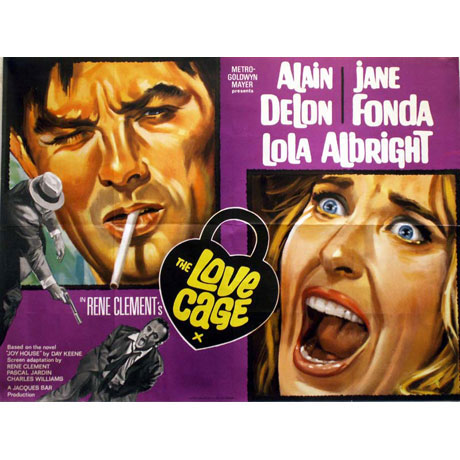
Joy House was produced by French film mogul Jacques Bar who had a very productive relationship with MGM; the studio distributed many of his European-made features in the U.S. such as Louis Malle’s A Very Private Affair (1962), Swordsman of Siena (1962), Any Number Can Win (1963) and Guns for San Sebastian (1968). The film opened in Paris under the title Les Felins with a running time of 110 minutes but the U.S. release version is listed at 91 minutes (what was cut?). MGM even released a ten minute promotional short on it under the title Filmmaking on the Riviera which used to air occasionally on TCM though I have never seen Joy House show up on the network. 
As previously noted, most U.S. critics dismissed the film as trash. Howard Thompson of The New York Times wrote, “It must have been the distinguished record of director René Clement that lured Jane Fonda and Lola Albright over to the French Riviera for the dismal claptrap called “Joy House.” The picture…is pure, pretentious baloney. Even the lush Cote d’Azur, wasted in black and white photography, comes out looking gray and bedragged in this Metro-Goldwyn-Mayer release….What a house! It’s a rambling villa—”neo-Gothic,” in Miss Fonda’s own word, and the same applies to the script and general behavior….Mr. Clement should have exposed these sick, dull characters to a bit of “Purple Noon”—that is, piled them into that Rolls-Royce and out of that moldy mansion and plunked them down on a Riviera beach for some sunshine and fresh air. If ever a house needed airing, it’s “Joy House.”
Equally harsh was Stanley Kauffmann’s review in The New Republic: “The question of Jane Fonda’s development into an extraordinarily good actress, which I still think quite possible, is beclouded by her poor choice of vehicles. Her latest film is absurd….No summary of the silly plot is needed.” And then there is Judith Crist’s ultimate putdown: “Miss Fonda has some mysterious hold over Miss Albright. It’s not all Miss Fonda has – or at least so she attempts to indicate by alternately impersonating the Madwoman of Chaillot, Baby Jane, and her father, Henry; she’s a sick kid, this one.”
Crist listed Joy House on her top ten worst list for 1965 along with Otto Preminger’s In Harm’s Way, Joseph Losey’s Eva, Howard Hawk’s Red Line 7000 and John Guillermin’s Rapture yet she almost seemed to recant when she wrote, “…come to think of it, wasn’t it in Joy House that Jane Fonda or somebody says, “I broke the Ming – do we glue it together?” With lines like those lying around loose, can any movie really be bad? After all, isn’t it a function of film, to borrow a lyric phrase from the dubbed narrator of Buddha, to “blighten the rives” of the oppressed?” It’s almost like Crist and the rest of these oh-so-serious film critics can’t admit or give in to the pleasures of Joy House without fear of losing their film snob credentials. But if the film didn’t get any respect, neither did director Rene Clement at this point in his career.
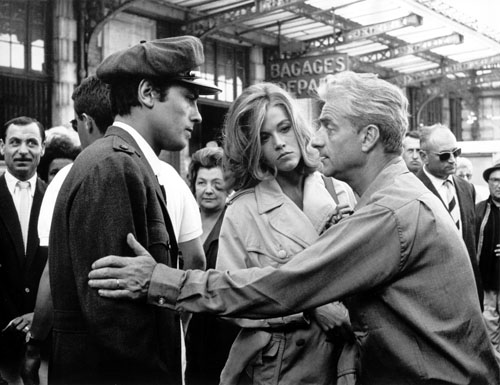
Les Felins (1964) aka The Love Cage aka Joy House
Directed by Rene Clement
Shown: Alain Delon, Jane Fonda, director Rene Clement on set
Made toward the end of the French New Wave movement, Joy House is not really representative of that cinematic outpouring that included the films of Truffaut, Godard, Agnes Varda, Jacques Rivette and others. Rene Clement was from an older generation of filmmakers and his films were more traditional in form and narrative and studio produced and distributed yet he had acquired an international reputation and countless accolades for such film festival winners as The Battle of the Rails (1946 aka La bataille du rail), The Damned (1947 aka Les Maudits), The Walls of Malapaga (1949), Forbidden Games (1952) and Gervaise (1956); the latter three films all received Academy Award recognition. 
Some directors associated with the Nouvelle Vague were openly critical of Clement. Truffaut, for instance, in his book, The Films of My Life, wrote, “Clement’s talent is as an imitator. La Bataille du Rail was an imitation of sobriety (Malraux’s L’Espoir [Man’s Hope] multiplied by ten), just as Le Chateau de Verre was an imitation of rigor and elegance (a second Dames du Bois de Boulogne). Jeux Interdits (Forbidden Games) imitated the cruelties of childhood….Clement behaved like the pseudo-intellectuals with which French cinema is overpopulated, half-educated scholars for whom the height of genius is to remove from art anything that comes from the heart.” One can only imagine what he would have to say about Joy House.

Jane Fonda (background) and Alain Delon star in Rene Clement’s Joy House (1964) but who’s the body in the trunk?
Even in recent years, Clement’s once celebrated reputation as a filmmaker has been downgraded or rendered minor by such film scholars as David Thomson in The New Biographical Dictionary of Film. But I think Clement’s filmography deserves a second look and I still prefer his version of The Talented Mr. Ripley – released as Purple Noon (1960) with Alain Delon as the ideal Ripley over the lavish, sprawling Anthony Minghella remake in 1999, which lacked the tension and concise economy of Clement’s original.
Most film historians who admire Clement think his work begins to deteriorate after Purple Noon. On the other hand, I think there is great fun to be had with Joy House and the later Charles Bronson-Marlene Jobert suspense thriller Rider on the Rain (1970).

Lola Albright (left), Jane Fonda and Alain Delon are up to no good in the menage-a-trois thriller, Joy House (1964), directed by Rene Clement.
Another Joy House advocate is Village Voice/Sight and Sound film critic Michael Atkinson who referred to it on an IFC film blog as “Rene Clement’s rather delightful 1964 suspenser,” adding, “There’s not much that’s earth-shaking about “Joy House” (except perhaps Lalo Schifrin’s pre-Jerry Goldsmith score). But it’s a movie in a way movies haven’t been in a long time: graceful, relaxed, fun-loving, unpretentious. What you get is Alain Delon in his best persona — a ne’er-do-well playboy flitting around the Mediterranean looking for cash and ass, not unlike his Tom Ripley in Clement’s “Purple Noon” four years earlier….It’s the kind of American pulp French filmmakers have always loved: the kind in which not one character has an iota of honesty or morality to them. This is my idea of escapism, hanging in an absurd vacation-France inhabited by nuns and sex kittens, digging the redoubtable chemistry between Fonda and Delon (honestly, Fonda’s so game and sexy here she’d muster chemistry with Fernandel), enjoying the stars’ indulgent wallow in the Riviera as I’m also casually and effortlessly following the not-too-fast narrative without the benefit of a single optical effect or a single moment where the film insists on “making” me “feel” the action.”

Vincent (Andre Oumansky) and Barbara (Lola Albright) have a paranoid discussion in the French thriller Joy House (1964), directed by Rene Clement.
The good news is that Joy House is not a lost film; you can still see it. The bad news is that neither DVD version available is ideal. Here are comments from DVDBeaver on the state of both versions of this film: “Image Entertainment distributed a single-layered unconverted PAL-sourced transfer of René Clément’s Joy House (Les Felins). It was bare-bones in a snapper case and was eventually fetching ridiculous prices on auction from third party profiteers on Amazon’s Marketplace.
Koch Lorber later comes to the rescue (or do they?) with a dual-layered, bare bones, interlaced, contrast -boosted replacement. It offers the French (with optional subtitles) or English audio (no subtitles) version of the film but the combing is horrendous with lots of artefacts – worse than the improper-standard ‘ghosting’ on the old Image disc. The Koch Lorber transfer is also slightly pictureboxed with a black border circumventing the frame.” At least you can tell from watching either version how much fun it would be to see Joy House restored on the big screen or even on Blu-Ray. It’s not likely to happen but I can dream, can’t I?

Joy House (1964 France) aka Les Felins aka The Love Cage
Directed by Rene Clement starring Alain Delon & Jane Fonda
Other websites of interest:
http://www.frenchfilms.org/biography/rene-clement.html
http://mondo70.blogspot.com/2011/06/les-felins-joy-house-1964.html
http://classiq.me/style-in-film-les-felins
https://www.youtube.com/watch?v=krC-v6sQ36g
http://daithaic.blogspot.com/2010/12/villa-torre-clementina-roquebrune-cap.html
https://www.theguardian.com/film/2017/mar/31/lola-albright-obituary




